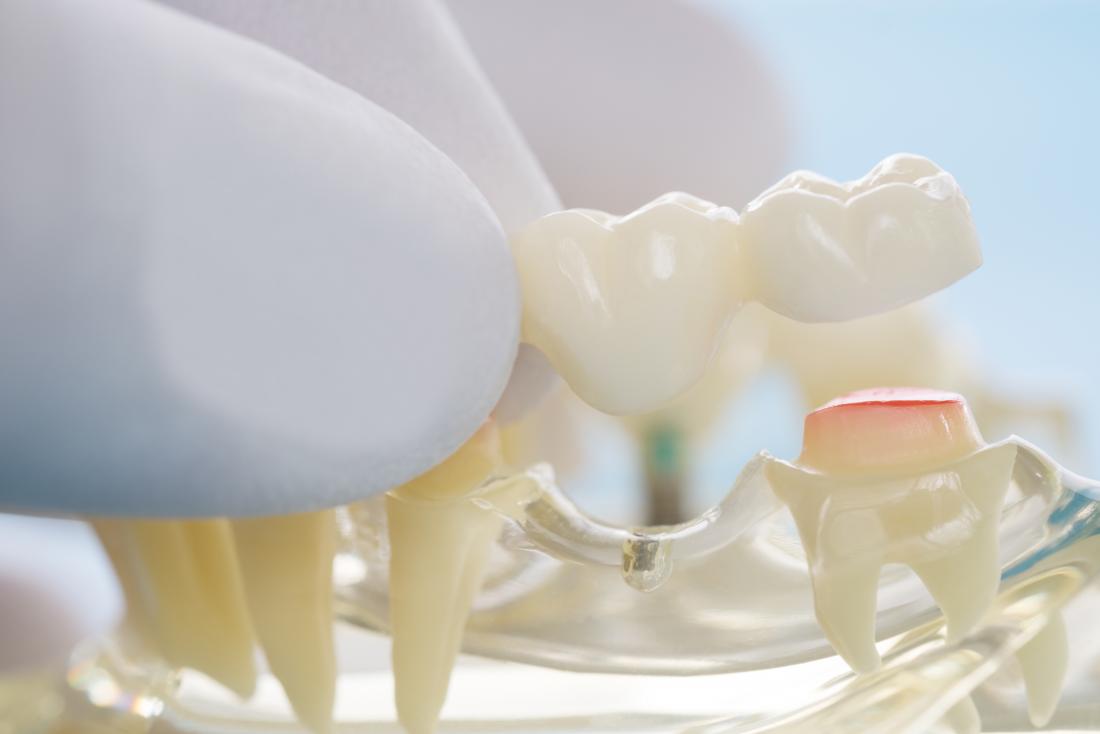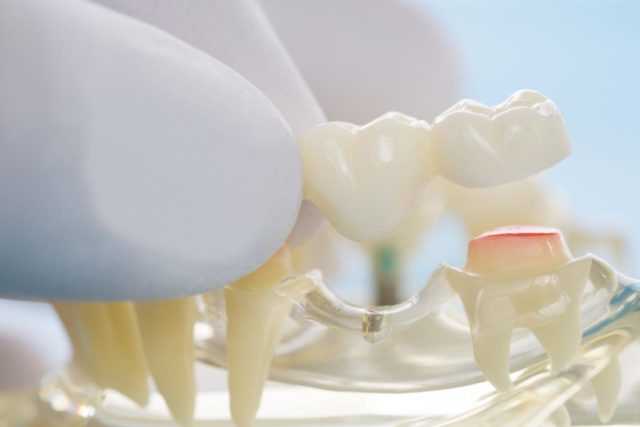A dental bridge replaces one or more missing or broken teeth with fake teeth. Bridges use one or more real teeth on either side of the gap to hold the fake teeth in place.
Bridges may be either fixed, which means that they are permanent, or removable, which means that a person can take them out.
Dentists call each fake tooth in a bridge a “pontic,” and some healthcare providers refer to a bridge as a “fixed partial denture.”
In this article, learn more about dental bridges.
 Share on Pinterest
Share on PinterestA dental bridge can replace a tooth or several teeth. The fake teeth in dental bridges look and function like real teeth.
For a bridge, a person may see a prosthodontist, a dentist who specializes in restoring and replacing missing teeth, or a regular dentist. Either way, there are many options for filling a gap in a smile.
One option is to have a crown — a fake bit of tooth attached to a small portion of real tooth that the dentist has ground down.
When a person has lost a tooth or the dentist has had to remove it, however, a crown alone is not an option, and a dental bridge may be the best choice.
The term “bridge” refers to a structure that contains one or more fake teeth. The structure is often anchored in place with one or more crowns on either side of the gap in the mouth. For example, if a person loses several front teeth, due to injury or decay, a doctor may use a bridge to fill in the gap.
A person may not wish to have a gap in their teeth, after having a tooth removed, for example, because they need a tooth in the area for chewing or because of cosmetic concerns.
For some people, a permanent dental implant is an alternative to a bridge. Dental implants are fake teeth that dentists surgically insert into bone in the mouth.
For others, dentists recommend implants to help secure a bridge, particularly if many teeth are missing.
A dental bridge can help a person feel more comfortable with their smile. It can also enable them to chew normally.
When a person loses one or more teeth, it can affect their bite, causing pain or difficulty eating. Replacing those teeth prevents these complications.
A person may need a bridge if:
- a tooth is so decayed that it falls out or a dentist removes it
- an accident or injury damages a tooth beyond repair
- decay or infection is so deep within a tooth that neither a filling nor a root canal are sufficient
Types
Dentists use several types of bridges:
- A traditional bridge involves two crowns — sometimes called abutments — anchoring the fake tooth or teeth. This is the most popular type of bridge, and it can be fixed or removable.
- A cantilever bridge requires only one crown for support. This involves a less intensive procedure and may be a good option for people who do not want to damage healthy teeth. However, the single crown can act as a lever, increasing the risk of tooth and jaw damage.
- Maryland bridges are more conservative and less invasive than traditional or cantilever bridges. The bridge is anchored by metal or porcelain frameworks attached to the backs of teeth on either side of the gap. These bridges can preserve healthy teeth, but they are less secure.
- Implant-supported bridges use dental implants as anchors. This type of bridge is more expensive and invasive but more secure.
The specific procedure depends on the type of bridge.
When a person gets a traditional bridge, the process begins by preparing the teeth on either side of the gap. The dentist will grind down these teeth, removing any decay. Next, they will take an impression of the mouth that will help with fitting the bridge.
The dentist will put a temporary bridge on the damaged teeth to protect them. Temporary bridges include structures that look like real teeth, but they are not permanent, so it is crucial to return to the dentist within a few weeks.
Once the real bridge is ready, the dentist removes the temporary structures and affixes the bridge using strong adhesives.
The process is similar for cantilever bridges, though only one tooth will need a crown. A Maryland bridge requires less preparation, since no crowns are involved. Both of these bridges also require at least two appointments.
When a person has implants to support a bridge, the process typically begins with implant surgery. Afterward, the dentist will take an impression of the mouth to create a bridge that fits over the implants seamlessly.
A person’s mouth may feel tender and sore after a dentist grinds down the teeth. It may also feel sore after the placement of the bridge. The gums may be tender and bleed.
For most people, this soreness goes away after a few days. However, the gums may need a few weeks to completely heal from the procedure.
A person can return to work or school as soon as they feel well enough, and this is usually the day after the appointment.
People who choose to be sedated during the bridge placement should not drive after the procedure.
Anyone who has implants may feel unwell after waking from anesthesia. They, too, should not drive and may need assistance for a day or two after the procedure.
To care for a bridge, it is important to:
- Practice regular oral hygiene to prevent further decay.
- See a dentist twice a year so that they can check the bridge and clean the teeth.
- Ask the dentist if it is important to avoid certain foods.
Some complications of a dental bridge can include:
- Bridge failure. The bridge may break or slip out of place. A person may then need another bridge, implants, or other dental procedures.
- Pain or chewing problems. Some people struggle to adjust to chewing with a bridge, especially in the weeks after the procedure. If the bite does not feel right, return to the dentist for an adjustment.
- Infection. Some people develop infections after treatment, especially if they have widespread tooth decay or gum disease.
- Tooth decay. It is possible for a tooth to continue to decay under the crown that anchors the bridge. This is more common in people with serious gum disease or very severe cavities in the teeth that need crowns.
To prevent tooth decay around a bridge, it is crucial to practice excellent home care, including brushing and flossing. Some floss products are designed for use with bridges.
Working with a knowledgeable dentist and carefully following their aftercare instructions can reduce the risk of serious complications.
Decaying or missing teeth can affect a person’s appearance, ability to eat certain foods, and quality of life. Dental bridges restore the bite and smile.
All dental prostheses come with risks and benefits. Discuss these factors and all options thoroughly with a dentist before committing to any procedure.
Let’s block ads! (Why?)






